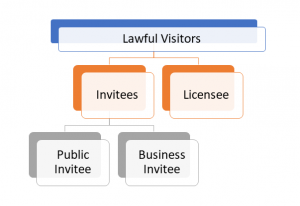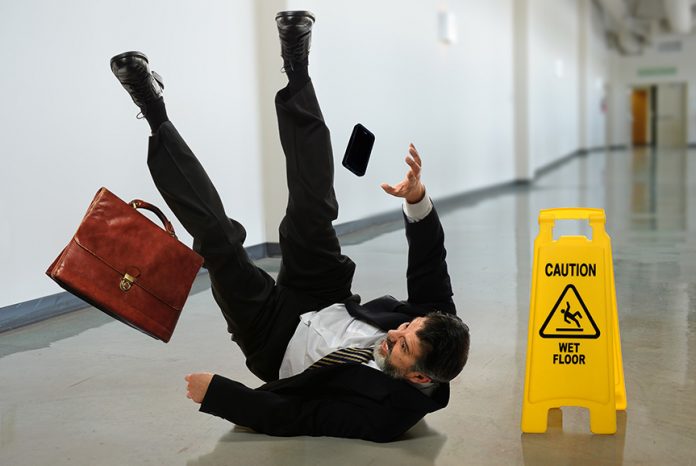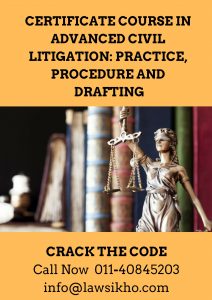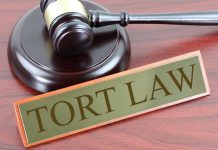This article is written by Nidhi Chhillar, student of Vivekananda Institute of Professional Studies, GGSIPU. In this article she has discussed about the liability of occupier towards lawful visitors, trespassers and children.
Introduction
Does an occupier of the premises owe an obligation to the people who enter his premises? Can the people who enter the premises sue the owner if they are injured? What would be the case if the person entering the premises is a trespasser or a child?
An occupier of premises or of other structures such as cars, ships, aeroplanes or lifts owes an obligation to the people entering the premises for their safety.
Until 1957, the rules which decided the liability of the occupier were extremely complicated. But it has now been simplified in England after the Occupiers’ Liability Act, 1957 has been passed.
The nature of obligation varies according to the kinds of persons visiting the premises. The Obligation of the owner will thus, be studied under three heads:
- Obligation towards lawful visitors
- Obligation towards trespassers
- Obligation towards children
Who is an Occupier
The occupier who has control of the premises need not be the physical occupier or owner. There is no test to determine if a person is an occupier or not. Thus, the facts of the case will determine the liability.
Wheat v. Lacon [1]
FACTS: The Manager of the Pub had the authority to lend the rooms even though he was not the owner. A paying guest died by falling from an unlit staircase. Consequently, an action was brought against the defendants. Defendants contended that the bulb of the staircase was removed by the stranger and thus, they were not negligent.
HELD: The House of Lords held that the defendants were the owner of the pub and thus, could be made liable for the dangerous premises but in this case, the mere fact that the staircase was unlit does not render the premises dangerous, as the injury could have been avoided if the person had been careful.
Obligation towards lawful visitors

The position was governed by Common Law rules until the Occupiers Liability Act, 1957 was passed. However, the old rule is still important as Judges continue to apply the old Common rule while deciding the liability of the owner. The law in this area has been continuously evolved. Under Common law the visitors were classified into two categories:
(1) Invitees
(2) Licensees
Separate rules were laid down for obligations towards each one of them.
Invitee: The visitor was known as Invitee if the visitor and the occupier of the premises had a common interest in the visit of the visitor.
For Example, a person going to a shop was termed as a visitor, no matter if he had bought something or not.
Invitees can be further subdivided into two categories:
- Public Invitee: This includes people who enter or remains in premises as a member of the public for the purpose for which the premises is open for the public.
- Business Invitee: This includes the people who enter or remains in premises for the purpose which is directly or indirectly related to the business of the occupier.
Licensee: When the visitor had no interest in the business of the owner and enters the premises with the consent of the owner of the premises then he was known as Licensee. A Licensee can be considered as a Social Guest.
Duty Towards an Invitee
The occupier was supposed to take the highest degree of care towards an Invitee. The owner of the premises had the duty to ensure that the Invitee was safe from any dangers in the property.
The occupier’s liability in case of Invitee was for loss caused by an unusual danger, in this respect he was not only liable for the danger about which he was actually aware of, but also for the danger which he ought to have known.
It must be noted, that the occupier was required to take reasonable care to prevent any damage to the invitees. Reasonableness varied from case to case, depending upon the facts and circumstances of each case. Thus, the person was required to take reasonable care which a prudent person would have taken under similar circumstances.
For Example, it is reasonable to expect from the shopkeeper to have regular inspections but it is unreasonable to expect that he will keep a watch the whole day if something is split on the floor.
Case Laws
The above stated rule was laid down for the first time in:
Indermaur v. Dames [2]
FACTS: The plaintiff, a gas fitter entered the premises of the defendant’s to examine the gas regulator. While doing so, he fell from an unfenced opening of the floor and consequently injured himself. Plaintiff then brought an action against the defendant to recover damages for the injuries.
HELD: In this case, the three categories of visitors were established:
- Invitees,
- Licensee, and
- Trespassers.
It was held by the court that the Plaintiff, in this case, was an Invitee as he entered the premises for the business purpose. It was observed by the court that the defendants were aware of the danger and therefore they owned the duty towards the plaintiff to tell about the same. Thus, the defendants were held to be liable.
Cates v. Mongini Bros [3]
FACTS: Plaintiff, went to defendant’s restaurant to have lunch. The Plaintiff sat under a ceiling fan. The ceiling fan fell on the Plaintiff, whereby injuring her. The Plaintiff subsequently brought an action against the defendant.
HELD: It was held that ceiling fan had fallen on the Plaintiff because of some latent defect. Thus, the defendant could not have discovered the defect. The defendant was held not liable.
Duty towards a licensee
As discussed earlier, a licensee is a person who enters the occupier’s premises with his express or implied consent, not for the benefit of the occupier but for his own purpose.
- Under the Common Law, the occupier had the duty to provide the details about any latent defect, which he was aware of. However, the occupier was not liable if the danger was not known to him. The owner was also not liable for the danger which was obvious and that the licensee appreciated the same.
- The owner of premises owed a duty that he would not injure the licensee intentionally or maliciously.
- Reasonable notice was to be given to the Licensee if new danger was created.
Case Laws
Fairman v. Perpetual Investment Building Society [4]
FACTS: Plaintiff along with his sister went on to stay in a room which was tenanted by the defendant. There was a common staircase which was owned and controlled by the defendant.
There was a depression in one of the stairs, the Plaintiff’s heel was caught in the depression thereby injuring her. Plaintiff brought an action against the defendant alleging that the Plaintiff was the licensee and therefore, the defendants owed extraordinary care towards them.
HELD: It was held that the defendants can be made liable only for concealed danger and not for the danger which was obvious. It was observed that in this case, the plaintiff could have avoided the injury if she had been careful. The danger was obvious and she could have observed it.
Occupiers’ Liability Act, 1957
With the passing of Occupiers’ Liability Act, 1957, the distinction between invitees and licensee has now been done away with.
Now, the same rule is applied for all lawful visitors. The occupier of the premises is expected to observe reasonable care which is known as “Common duty of care”.
Section 2 of the Act, discusses the extent of the occupier’s duty.
- An occupier owes the common duty of care towards all his visitors. Common duty of care means a duty to take such reasonable care which will render the premises safe for the visitor for the purpose for which he was invited or permitted by the occupier.
- An occupier can exclude, extend or modify his duty by entering into an agreement with any of the visitor or visitors.
- An occupier is expected to take special care of children as they are supposed to be less serious than adults.
Case Laws
Roles v. Nathan [5]
FACTS: The defendant was the owner of premises which was centrally heated by the coke-fired boiler. Two chimney sweepers tried to seal up a sweep hole, in the chimney but died because of the presence of carbon monoxide gas. The deceased were warned about the danger but they had disregarded the instructions and warnings.
HELD: It was held that the danger was obvious and the deceased were told about the danger, therefore, the deceased had appreciated the same. It was further stated that the defendant was not negligent and therefore, can not be made liable.
Klaus Mittlebachert v. East India Hotels Ltd. [6]
FACTS: The plaintiff was a co-pilot in Lufthansa Airlines. The plaintiff went on to stay in a 5 star hotel in Delhi. He took a dive in the swimming pool, his head hit the bottom of the pool and therefore, he suffered severe injuries. He remained paralysed for 13 long years and consequently died. It was found that the reason behind the injury was the insufficiency of water in the pool.
HELD: It was held that the defendants were negligent as the design of the swimming pool was defective. Thus, the defendants were held to be liable.
Duty of the owner of the structures adjoining Highway
- The buildings or structures adjoining Highway must be maintained in such a way that they do not become dangerous for the users of the highway.
- If any injury is caused to the user of the highway because of the dangerous nature of the structure or building then the owner will be liable for the same.
Municipal Corporation of Delhi v. Subhagwanti [7]
FACTS: The clock tower was situated opposite to the Town Hall in Chandni Chowk, New Delhi. The structure belonging to the Municipal Corporation collapsed which resulted in the death of a number of people. It was found that the structure was 80 years old and the MCD failed to take care of the structure.
HELD: It was held by the Supreme Court that the defendants were liable as they were negligent in taking care of the structure. The defendants were liable for the potential threat caused by the structure.
What is the liability of Landlord
Generally, when a building is given on rent to a tenant, then it is the tenant who is liable to the visitors for any damage caused to them in the premises. However, the landlord can be made liable under certain circumstances, some of them are being discussed below:
- Common Areas: The landlord is liable for the damage caused to the visitors or tenant in common areas which are shared by all the tenants. For example, parking lot, hallways, staircase, etc.
- Latent Defects: If the defect is such that the landlord was aware of, before entering into an agreement of tenancy but did not disclose about the same to the tenant, then any injury caused because of such defect to the visitors will make the landlord liable.
- Contractual obligation to repair: Generally, the landlord is not responsible to make repairs in the building. However, if he had entered into an agreement with the tenant, undertaking to repair the building whenever necessary. Then it will be the landlord who will be responsible if any injury is caused to the visitors because of the negligence in repair.
However, these heads will be effective only if there is no agreement to the contrary. Thus, if the landlord has restricted his liability in an agreement with the tenant then the landlord will not be liable for the same.
Mint v. Good [8]
FACTS: The defendant had let a building on weekly tenancy. No right was expressly reserved by the defendant to enter the premises. Plaintiff was injured by the collapse of a wall of the building lent by the defendant.
HELD: It was held that the right to enter the premises can be implied from the circumstances, thus, the defendant was held liable.
Obligation towards trespassers
The Occupiers’ Liability Act covers only the liability of occupier towards lawful visitors and not towards the trespassers. Thus, the obligation towards trespassers is still covered by Common Law.
Who is Trespasser
A trespasser is a person who enters the premises of another without his consent. However, if the occupier did not object the entry of others on the land then it is assumed that he had consented for the same. Such visitors then get the right of the licensee.
Lowrey v. Walker [9]
FACTS: The defendant was the owner of the land which was used by the public as a shortcut from and to the railway station. The defendant objected to this practice but had never taken an effective action against the same. The plaintiff, while crossing the field was injured by the horse which was owned by the defendant. The defendant contended that the plaintiff here, was a trespasser and therefore he had no duty against him.
HELD: It was held by the court that since the defendant had failed to take effective action against the trespassers for such a long time, therefore, the presence of consent of the defendant can be assumed in such circumstances. It was observed that the plaintiff was a licensee in this case and therefore, the defendant was held liable for the injury.
Nature of duty towards trespassers
- The occupier is not supposed to make his premises safe for the trespassers
- However, he cannot deliberately do an act to injure the trespasser. The occupier has the right to take reasonable steps to prevent trespassers from entering the premises but he can not do anything to harm them. For Example, if the trespasser is injured by falling from the staircase then the occupier will not be liable, but on the other hand, if the trespasser is injured because of the spring guns on the wall of which the owner has not given any notice, then the owner will be liable.
- The occupier of the premises owes a duty of ordinary care.
Mourton v. Poulter [10]
FACTS: The defendant was cutting an elm tree near which the children were known to be present. The defendant did not warn the children, thus injuring a child standing nearby. When an action was brought against the defendants, they contended that the child was a trespasser in the premises.
HELD: It was held that the defendant was liable because he had failed to give adequate warning to the child.
Obligation towards Children
Occupier’s Liability Act, 1957 provides that the occupier of the premises is expected to be prepared for the children to be less careful than adults. Therefore, the occupier is required to take reasonable care to prevent the infliction of any danger on the child.
The occupier is supposed to protect the children even from the dangers from which the adults need no protection. The rationale behind this is that the child is not capable to form a decision or act in a similar manner in which the adult would have acted under similar circumstances.
Glasgow Corporation v. Taylor [11]
FACTS: The public park was controlled by the defendants. There was a tree with poisonous berries, however, no notice was given for the same and the access to tree was open to the public. A child of 7 years ate the berries and died. An action was brought against the defendant by the father of the child
HELD: The defendants were held liable, as they have failed to give any notice about the deadly character of the berries.
Conclusion
To sum up, the nature of obligation of an occupier varies with the kinds of visitors. If a person is a lawful visitor then the occupier has the duty to take reasonable care towards the safety of the visitor and their property. Prior to the passing of Occupiers’ Liability Act 1957, lawful visitors were categorised into Invitee and Licensee, depending on the purpose of the visitor. However, now this distinction between an Invitee and Licensee has been done away with.
The landlord is generally not liable for the injury caused to the visitors. However, under certain situations, the landlord can be made liable for any injury caused to the visitor.
Duty of an Occupier towards children is generally greater, as the child can not be expected to act in a similar manner as an adult. Therefore, the occupier is expected to be prepared for the children to be less careful as compared to adults.
References
-
- [1966] AC 552
- [1866] LR 1 CP 27
- [1917] 19 BOMLR 778
- [1923] AC 74, 92 LJKB 50
- [1963] 2 All ER 908
- AIR 1997 Del 201
- 1966 AIR 1750
- [1951] 1 KB 517
- [1911] AC 10
- [1930] 2 KB 183
- [1922] 1 AC 44
- R.K. Bangia, Law of Torts
- Occupier’s Liability Act, 1957
 Serato DJ Crack 2025Serato DJ PRO Crack
Serato DJ Crack 2025Serato DJ PRO Crack











 Allow notifications
Allow notifications




Extraordinary information and superb explanation…..am searching for these type of explanations…tq so much